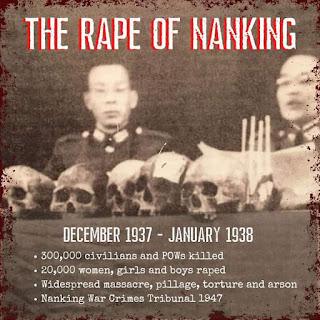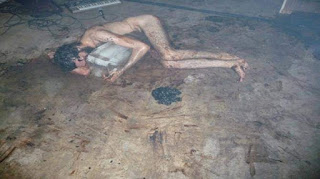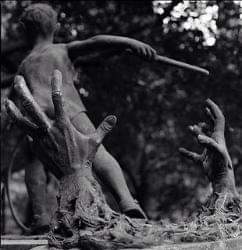RAPE AND OTHER ATROCITIES COMMITTED DURING WAR.
WARNING! PHOTO BELOW ARE NOT MET FOR THE WEAK HEART.
Please note: The following subject matter is of immense importance, but could be difficult to read. There is a frank discussion of rape and other atrocities committed during war.
After entering a large museum in one of the world’s most ancient cities and the former capital of the Chinese empire, Nanking—or Nanjing as it’s known today—my 18-year-old daughter Sophia and I walked over a glass walkway that allowed us to look down 10 feet of earth and observe an ancient footpath. Lights highlighted the ground under the glass while the room we were in was dark.
To our right hung numerous photographs on a black wall showing Japanese soldiers slaughtering Chinese citizens in December 1937 revealed by individual lights, the types one sees on art museum paintings. Dead babies, severed heads, piles of bodies on Yangtze River banks, and helpless prisoners of war were all documented there by photographs taken by the perpetrators themselves, Imperial Japanese Army soldiers who had conquered Nanking.
The photo collage documented an orgy of slaughter. Walking along the pathway, there was a rectangular centerpiece in the hall ringed by 3-foot walls. Many, on gazing over the lips of the precipice, shook their heads. Some put their hands together and offered prayers to the heavens. Others whispered to companions, “Bastards,” “I hate the Japanese,” “How can Japan deny this?” or “America should’ve dropped more bombs on the assholes.” Visitors’ eyes were grave and focused. The air vibrated with their energy.
My daughter, standing 5’11” with blond hair and blue eyes stood out in the crowd of mostly local Han Chinese. Everyone was silent except for those walking away from the centerpiece. Sophia looked over the wall first and then she glanced at me with wide eyes filled with sadness. I thought of what Dante wrote in the Inferno: “In truth I found myself upon the brink of an abyss, the melancholy valley containing thundering, unending wailings.” As I looked over, I beheld a mass grave.
Many skulls showed signs of having either been crushed by a heavy object or shot by a bullet. Other skulls had been removed from their bodies, settling several feet away from the shoulders. Sophia and I weren’t aware yet that this crime scene was not even close to being the museum’s biggest.
One much larger awaited us in another building where hundreds of bodies lay; old ladies, POWs and children, their remains bearing evidence the Japanese had killed them with guns, swords and clubs. We were walking over a massive unplanned cemetery where everyone had met an untimely and murderous end; the Japanese had “stained the world with blood” to quote Dante again. Lining the exhibit were jars of human remains mixed with the earth that had absorbed their flesh.
My daughter and I were visiting one of the largest crime scenes in history. Sophia was accompanying me because she is fluent in Chinese and was helping me conduct research. On this day, our journey took us to The Memorial Hall of the Victims in Nanjing Massacre by Japanese Invaders in Nanjing. I had been to the Holocaust Museum in Washington D.C., Yad Vashem in Jerusalem, Memorial to the Murdered Jews of Europe in Berlin, and Auschwitz, the Nazi extermination camp in Krakow, Poland, but nothing had prepared me for this massive complex built to remind the world of the Rape of Nanking. The European sites show evidence of mass murder with Auschwitz being the most dramatic. The former death camp had large rooms full of shoes, shaven female hair and suitcases of the deceased. However, here we observed hundreds of skeletons, often with their empty black eye sockets starring at us as if pleading to never forget. The gloomy air vibrated with messages from their shattered bones, relying on the living to recount their stories. The sheer size of the extermination reminded me of Dante’s phrase: “I should never have believed that death could have unmade so many souls.” How could an apparently cultured civilization like Japan unleash soldiers who could commit such atrocities?
Before and during World War II, Japanese fascists preached that everything Japanese was superior and anything non-Japanese barbaric. Gaijin (or non-Japanese) were viewed as non-human. For decades, Japanese citizens had been indoctrinated with “evidence” that Japan’s enemies, like Caucasians and Chinese “were inferior, even subhuman creatures for whom no respect was possible.” Uno Shintarō, who beheaded prisoners, wrote, “we never really considered the Chinese humans. When you’re winning, the losers look…miserable. We concluded that the Yamato race was superior.” George Orwell wrote that for centuries, the Japanese preached “a racial theory…more extreme” than the Nazis, claiming “their own race to be divine and all others hereditarily inferior.” James Young, a former Japanese prisoner, wrote an insightful 1940 book Our Enemy in which he supported Orwell’s conclusions, writing about the Nanking massacre: “[The Japanese] duplicat[ed] all Nazi brutalities, exceed[ed] them, and add[ed] a whole satanic range of their own peculiar cruelties.” This was especially exhibited during the Rape of Nanking, which encompasses for my study the Imperial Japanese military march from Shanghai in November 1937 to the final destruction of Nanking in January 1938.
The majority of the slaughter happened after the Chinese army of 150,000 (the Nanking Garrison Force) disintegrated under the better led and equipped Japanese by mid-December. The majority of Chinese soldiers (approximately 90,000) had laid down their arms, 10,000 had died in battle defending Nanking, and 47,000 had escaped west. Many have asked why the Chinese did not fight more ferociously at Nanking. Chiang Kai-Shek’s men had fought bravely around Shanghai for months, inflicting thousands of casualties on the IJA in protracted urban warfare that started in September 1937, but when his men retreated in November to Nanking, it was an exhausted force and city leaders had not prepared the capital for defensive battle. The Chinese commander, General Shengzhi Tang, abandoned Nanking and the majority of his troops. He was ordered to leave by Chiang Kai-Shek (who along with his wife also had abandoned the city), but one would think he and the Generalissimo would have looked out for their troops before leaving. Without effective leadership, the Chinese soldiers showed little initiative and caused much “military confusion.” As a result, the Chinese at Nanking were quickly defeated.
Capturing so many prisoners of war, the IJA resorted to wholesale butchery. Military correspondent Yukio Omata provided testimony to the POW executions:
“Those in the first row were beheaded, those in the second row were forced to dump the severed bodies into the river before they themselves were beheaded. The killing went on non-stop, from morning until night, but they were only able to kill 2,000 persons in this way. The next day, tired of killing in this fashion, they set up machineguns. Two of them raked a cross-fire at the lined-up prisoners. Rat-atat-tat. Triggers were pulled. The prisoners fled into the water, but no one was able to make it to the other shore.”
It is estimated that out of the 300,000 individuals murdered during the campaign from Shanghai to Nanking in the winter of 1937-38, some 80,000-90,000 were defenseless National Chinese POWs. “It was a slaughter, a massacre” according to many historian Sun Zhaiwei. IJA commander at Nanking, General Iwane Matsui, “lacked any idea that the killing of POWs was a violation of international law and a grave crime against humanity” to further quote Zhaiwei. At the same time defenseless POWs were killed by Matsui’s 10th Army, rapes were occurring everywhere. A graphic interview given by IJA soldier Shirō Azuma who committed such crimes was stunning:
“At first, we used some kinky words like Bikankan. Bi means “[Pussy],” Kankan means ‘look.’ Bikankan means, ‘Let’s see a woman open up her legs.’ Chinese women didn’t wear underpants. Instead, they wore trousers tied with a string. There was no belt. As we pulled the string, the buttocks were exposed. We ‘Bikankan.’ We looked. After a while we would say something like, ‘It’s my day to take a bath,’ and we took turns raping them. It would be all right if we only raped them. I shouldn’t say all right. But we always stabbed and killed them. Because dead bodies don’t talk.”
Yale University historian Jonathan Spence wrote that Nanking’s “period of terror and destruction” ranks “among the worst in…modern warfare... [It was] a storm of violence and cruelty that has few parallels.” Today in the Chinese consciousness, it is as significant for them as Auschwitz is for Jews. The 200 miles between Shanghai and Nanking in the fall and winter of 1937 was a flotsam of rape and dead bodies, a literal “carnival of death” according to the Museum of the Pacific War in Fredericksburg, Texas.
Horrible executions and gratuitous murder were observed at Soochow, a mid-point between Shanghai and Nanking and its devastation mirrored countless other towns. Similar acts happened in cities surrounding Nanking such as Mufushan, Wuhu, Nit’ang, Wuxi and Suzhou. This Japanese pattern of behavior demonstrates that “these murders followed such a similar pattern over such a wide range of territory and covered such a long period of time, and so many were committed after protests had been registered by neutral nations that…only positive orders from above [like Prime Minister Hideki Tojo and Emperor Hirohito] made them possible” according to historian James Scott.
As a result of troops being sent to conquer Nanking without supplies, they had to source their own food. In doing so they did not have to destroy thousands of homesteads, but they did so anyway. Victims called the IJA Huang-chün, an “army of locusts.” Japan used this campaign to create fear and submission.
Civilians were massacred openly to entertain soldiers and encourage others to conduct themselves similarly. The IJA soldiers acted “beyond the bounds of permitted aspirations” to quote Joseph Conrad from his work "Heart of Darkness."
Besides seizing more territory and resources for Japan, another reason for taking Nanking was that it was Chiang Kai-Shek’s Kuomintang capital. Taking this city was not only a military victory, but also a triumph politically and psychologically, showing the world Japan waged a “war of annihilation.” For destroying and raping Nanking, Hirohito decorated his generals with medals.
All these Nanking atrocities happened with the encouragement, approval and knowledge of Japanese commanders: General Iwane Matsui (Commander 10th Army), Lieutenant General Hisao Tani (6th Division Commander), Lieutenant General Kesago Nakajima (16th Division Commander) and Lieutenant General Prince Yasuhiko Asaka (Hirohito’s 50-year-old granduncle), an ultranationalist on the Supreme War Council. After battle started, Lieutenant General Nakajima lent his sword to help a subordinate fulfill such criminal orders: “Takayama Kenshi visited me at noon today [13 December]. There happened to be seven captives, so I asked him to try to behead them with my sword. I did not expect him to do such a good job—he cut off two heads.”
When IJA soldiers were not executing Chinese men, they raped women and girls. It became their obsession. “Chinese witnesses saw Japanese rape girls under ten years of age…and then slash them in half by sword.” Australian journalist Harold John Timperley called the Japanese “lust-mad.” In some cases, soldiers would enter a village, round up the men, escort them outside town and place them under armed guard. Then, IJA soldiers took turns returning to the village and raping the women. Chinese men would sit on the side of the road trembling as they heard the screams of their wives, daughters and sisters but could do nothing. In Nanking, two husbands who ran back for their wives to save them were shot by their guards. Women were taken to IJA camps and never heard of again.
Japanese went beyond rape and butchered women, killed infants and small children in front of their mothers and buried people alive. IJA soldiers castrated prisoners before using them for bayonet practice, or doused them with gasoline and lit them afire. They tortured the elderly to death. Some Nazis in the International Safety Zone, such as John Rabe, wrote Adolf Hitler to help stop these atrocities, calling the IJA “bestial machinery.” He also wrote the Japanese Embassy along with others for help detailing IJA crimes (the Embassy did nothing).
Dead women lay naked in the streets, brutally violated. IJA soldiers hunted citizens like rabbits. In fact, the killings would have been more widespread had the expatriate community, led by Nazi Party Member John Rabe who chaired the International Committee for the Nanking Safety Zone, not set up a precinct to protect civilians.
These expatriates saved 200,000 by defending a Japanese-free zone and using international pressure to keep IJA forces at bay. Although repeatedly badgered to provide them with women to rape, the expatriates refused to give into their demands, although they could not protect everyone and some were violated. Outside that zone, most Chinese suffered horribly.
By February 1937 things settled down, but the Imperial Japanese Army’s march to Nanking had added a landmass the size of Connecticut to the Empire and secured one of the most important ports in the world, Shanghai. The Japanese had utterly destroyed the Nationalist capital and devastated the entire population. For the next eight years, this whole region continued to suffer murder, rape and pillage. The Rape of Nanking goes down as not only one of the worst crimes against humanity during World War II, but one of the most horrible chapters in the history of humankind.
See photos:
For more about the Rape of Nanking and the importance of never forgetting this atrocity and its victims, see my book “Flamethrower”:
https://www.amazon.com/Flamethrower-Recipient-Williams-Controversial-Holocaust/dp/1734534109/ref=sr_1_1?dchild=1&keywords=flamethrower+bryan+mark+rigg&link_code=qs&qid=1592925332&sourceid=Mozilla-search&sr=8-1&tag=mozilla-20
#WWII #RapeofNanking #Nanjing #China #warcrimes




.jpeg)
.jpeg)
.jpeg)











Comments
Post a Comment